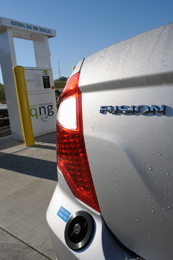WOOSTER, Ohio — The Ohio Agricultural Research and Development Center now has four environmentally friendly bi-fuel vehicles on the road as part of a new demonstration project.
Using $46,000 in grant funding from the nonprofit group Clean Fuels Ohio, the center recently had four of its fleet vehicles — three Ford Fusion sedans and a GMC Sierra pickup truck — converted to run on either gasoline or compressed natural gas (CNG), which is a less-polluting fuel that’s also cheaper.
OARDC officials expect most of the CNG burned in the vehicles to come from renewable biogas produced locally by one of the center’s industry partners, Cleveland-based quasar energy group.
The company operates a biogas-producing waste digester and CNG filling station on OARDC’s main campus in Wooster in northeast Ohio. It has similar facilities in Cleveland, Columbus and other locations.
“The whole idea is to get to a carbon-neutral environment, a carbon-neutral society,” said OARDC Associate Director Dave Benfield, one of the project’s leaders. “As a research organization, we talk about that with our clients: ‘How do we close the carbon cycle?’

“This is an example of being able to do that, because now we have a complete loop, from taking in the waste to digesting the waste to using it to produce an energy source.”
Recycling wastes
The quasar plant uses bacteria to turn food waste and similar materials into methane, which is collected and refined into CNG for motor fuel. Methane from the plant also powers a generator that provides about 30 percent of the electricity needs of the main part of OARDC’s campus, said John Ott, head of the center’s Facilities Services department.
Produce your energy
The system “means you can essentially produce your energy, at least a portion of it, from what is otherwise today a waste stream,” said Jim Currie, the director of OARDC’s ATECH program who led the grant application effort last year.
The Fusions are expected to log about 15,000 miles a year transporting scientists, support staff and graduate students to OARDC’s other locations for meetings and research, Ott said. The truck is mostly for shorter-range driving.
The center, which is the research arm of Ohio State University’s College of Food, Agricultural, and Environmental Sciences, also has personnel and facilities on Ohio State’s main campus in Columbus and at nine outlying research stations around the state.
The four vehicles represent slightly less than two percent of the 230-vehicle total fleet serving all of the center’s locations, Ott said. But Benfield said that if the new rides prove their mettle, “we may look at further conversions down the road.”
He recently drove one of the bi-fuel Fusions to Columbus and back.
“We did experiments in terms of switching back and forth from CNG to gasoline, and we didn’t notice any difference. We drove on I-71, and the pickup, power, everything was fine,” he said. “The great part about CNG for the end user is that the function of the vehicle remains the same,” said Michael Pallotta, owner of Pallotta Ford Lincoln in Wooster, which converted the Fusions.
“The ease of operation is there,” he said. “The miles per gallon and horsepower and fuel efficiency remain the same. And you have a little bit less wear and tear as far as maintenance on the vehicle goes.”
CNG compatible
The conversions feature a separate fuel tank and fuel line dedicated to CNG. The vehicles have a separate fuel gauge for CNG located on the dashboard and a console-mounted switch for changing between CNG and gasoline. The Fusions can run on CNG for about 200 miles, or a bit more than is needed to go from Wooster to Columbus and back, before having to switch to gasoline, Benfield said.
A U.S. Department of Energy (DOE) website says burning CNG instead of gasoline decreases a vehicle’s greenhouse gas emissions by 30 to 40 percent. The emission reduction includes about 25 percent less carbon dioxide, 65 percent less nitrogen oxide and 90 percent less carbon monoxide, according to a DOE study. “So we’re helping the environment, closing the carbon loop and practicing what we’ve been preaching for a number of years from a research standpoint,” Benfield said. And saving some green as well.
Quasar’s biogas-derived CNG currently sells for $2.25 per gasoline gallon equivalent, according to AltFuelPrices.com. AAA’s Daily Fuel Gauge Report on Dec. 5 listed the national average price for a gallon of regular gasoline at $3.38. Further details about the project are at http://go.osu.edu/Jnj.
STAY INFORMED. SIGN UP!
Up-to-date agriculture news in your inbox!











